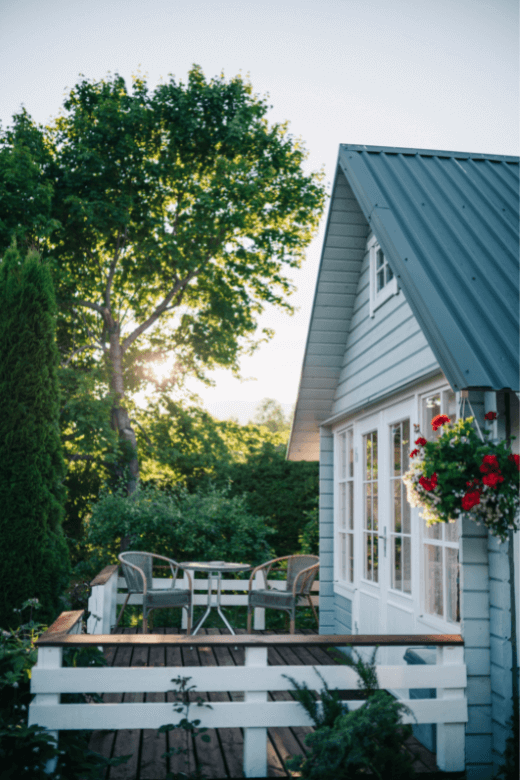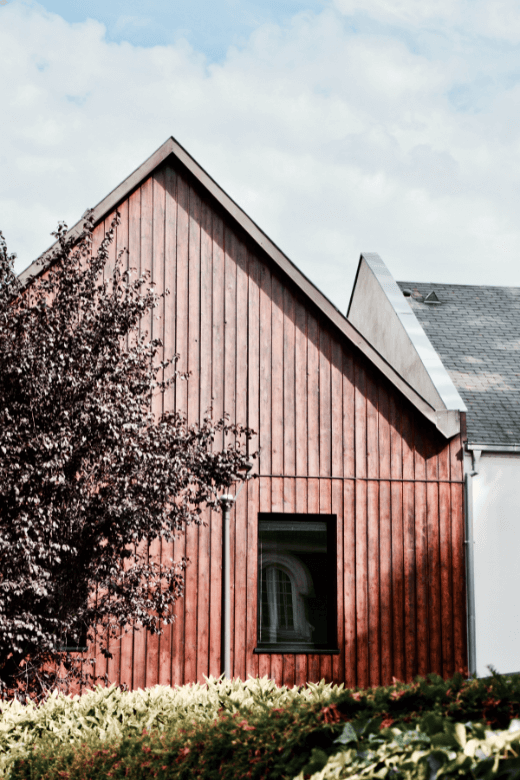In our experience talking with our customers, a lot people are afraid to plant trees close to their house. They’re often wary because of the following things:
Tree roots are going to destroy your foundation.
In reality, tree roots are primarily in search of fertile soil and moisture. House gutters, which concentrate a lot of rain into one area, tend to oversaturate your soil, resulting in less air, which is vital to tree roots. The soil around houses also tends to be more compacted than other areas, which isn’t ideal for root growth.
Tree roots tend to stay in the top 8-12 inches of soil. Most foundations in the Midwest are at least 4’ deep, much more if you have a basement. So, in order for tree roots to negatively affect your foundation, they would need to grow all the way down below your foundation to be able to impact it, unless you have a crack in your foundation that’s leaking water.
Leaves and debris in the gutters.
The best way to avoid leaves and branches in your gutters is to have the branches pruned away from your roof by a certified arborist. Some of the best trees to plant near your house are ones that don’t grow to an overwhelming size, and are easily shaped and pruned.
If your house is located in a wooded setting, you may have already installed leaf guards on your gutters, which can also cut down on the amount of litter that clogs your gutters.
Limbs falling on the roof or trees collapsing on your house.
By selecting trees that at maturity are of a medium or small stature, you’ll be unlikely to have a problem with limbs or trees damaging your house. It’s also essential to have your trees inspected and pruned regularly by a certified arborist (like us!). They’ll be able to remove weak or dead branches and limbs so this isn’t as big of a concern.

The Benefits of Planting Trees Near Your house
If you choose correctly, you can absolutely plant trees nearer to your house than you may think. As certified arborists and gardeners, we have definitely planted trees in the landscape beds around our homes. Here’s why you might consider it as well.
Produce shade
Planting trees closer to your house will shade your house sooner. A strategically placed tree can actually save you money. In the northern hemisphere, a tree planted on the south and southwest side of a home can save a homeowner up to 30% on annual air conditioning needs (USDA) by protecting it from the most intense sun of the day.
Wind protection
In winter, many of the harshest winds come from the north. If you planted one or several trees on the northern face of your house you could expect the same tree to reduce the heating energy needed by 20-50% (USDA) by blocking those severe winter winds.
Privacy/Screening
Vertical growing evergreens add a layer of screening from neighbors, roads, and other unwanted sights. They can also provide a bit of sound dampening by reducing road noise. A row of well-placed trees, such as arborvitae, can get taller than a fence and offer better screening. Trees can also provide privacy around a patio or porch or break up sight lines to your windows.
Curb Appeal
Planting trees adds visual interest to your landscape around your house. If your house is tall, or very wide, or you have large stretches of siding without windows, trees can break up the monotony. Having a mature tree in your yard can increase the property value by 10-15% (Theriault et al, 2001). A mature tree is usually appraised between $1,000-10,000 (Council of Tree and Landscape Appraisers).
Attract insects and wildlife.
Evergreens near bird feeders can provide a safe haven for visiting birds. A tree can be a home to various birds and critters and also provide winter food through berries and nuts.
Read more about tree planting benefits.

Best Trees to Plant Near Your House in the Midwest
There are a few things to take into consideration before planting a tree near your house. Make sure you are aware of the mature size of the tree. If the tree grows to be 20-30′ wide, you may want to plant it at a further distance from the house, 15-20′.
If the tree’s mature size is smaller than that, you can consider planting it closer. If you want shade sooner or you plan on pruning your trees on a regular basis, you can plant them closer to your home.
When researching the best trees to plant near your house, you can also look into trees that have a more vertical or upright habit, which eliminates the horizontal branching near the roof.
You do not want to plant trees that grow to a huge size and have a large spreading canopy, such as oak and maple trees. Although these trees can beautiful and majestic, (and we do plant them for our customers) they’re more appropriate for locations away from your home.
Finally, if you live in a high fire risk area, you should keep the area around your house free of plants, trees and vegetation that can lead to your house catching on fire.

small to medium trees to plant Next To your house
Crabapple. These trees provide good ornamental aesthetics by producing large amounts of gorgeous flowers in the spring, and the flowers turn to fruit that provides food for wildlife. They’re tolerant of heavy pruning, so they can be shaped and pruned away from your roof. When shopping for a crabapple tree, pick a variety that is more resistant to foliar diseases, which can be a problem in the Midwest. Mature Height: 10-25′, Mature Spread: 10-25′, depending on variety.
Dogwood (Pagoda, Kousa). These small trees have great visual interest, pretty flowers in the spring, grow to a limited height, and are easy to prune away from your roof. Mature Height: 15-25′, Mature Spread: 15-25′.
Columnar trees (oaks, ironwoods, maples). Columnar trees grow to a decent height, but their vertical growth means you won’t have to worry about branches spreading over the roof. They look striking in clumps and planting multiple trees can provide screening quickly. These trees require very little maintenance because they don’t need much pruning. Mature Height and Spread varies depending on variety.
Redbud. The electric purple of Redbud flowers are a show stopper every spring. These trees are small in stature, provide excellent shade, are very fast growing, and the leaves turn a striking yellow in fall. Mature Height: 25′, Mature Spread: 25′.
Ironwood. This is a native tree in many parts of the Midwest. It grows well in shady areas, features interesting, textured bark, is resistant to disease and insect problems, and produces attractive hop-like seeds in the fall. Mature Height: 25′, Mature Spread: 15′.
Musclewood. Although this Wisconsin native tree is slow growing, it’s very hardy and shade tolerant. It can be grown as a single stem tree or a multi-stem shrub. The leaves’ fall color ranges from bright yellow to orange-red. Mature Height: 25-30′, Mature Spread: 25-30′.
Upright Japanese Yew. Evergreens are slow growing and rarely require much pruning. This imported yew has finely textured needles and a dense, pyramidal shape. It is one of the few evergreens that can thrive in shade and offers year round color and interest. Mature Height: 15′, Mature Spread: 10′.
Witch Hazel. This Wisconsin native large scale shrub can be planted almost anywhere because it grows in both full sun and full shade. The fall color is a spectacular, bright yellow. Mature Height: 12-20′, Mature Spread: 12-15′.
Serviceberry. These multi-stemmed large shrubs or single-stem small trees thrive in full sun. Their large array of white flowers is a welcome sight in mid-spring and the flowers turn into edible berries that are high in antioxidants. Mature Height: 15-25′, Mature Spread: 15-25′, depends on variety.

Medium to Large Trees to Plant close to Your House
You don’t have to only stick to planting small trees near your house. There are some great choices in the medium to large category as well!
River Birch. These fast growing trees are popular in urban areas and thrive in wet soil conditions. They tend to have more vertical shape than other birches and are Bronze Birch Bark Borer resistant. They feature cinnamon-colored bark that peels off in an attractive way and they’re native to the Midwest. Mature Height: 40-70′, Mature Spread: 40-60′.
Katsura Tree. Because it’s of Japanese origin, the Katsura is pest resistant in the Midwest. It makes an excellent shade tree and its leaves emerge with a purple hue in the spring, mature to a blue-green in summer, and turn orange-yellow in the fall. Mature Height: 40-60′, Mature Spread: 20-35′.
Arborvitae. These trees are super popular in the Midwest because they grow quickly, and when planted in a row they eventually merge together into a hedge that can provide wonderful privacy screening. There are several varieties that will stay 5′ wide of less for areas with limited space. Arborvitae are evergreen, so they provide green color all year round. Mature Height/Mature Spread: depends on variety.
Bald Cypress. This tree is a deciduous conifer, which means its needles drop in the winter. It will provide summer shade, but because it sheds its needles later in the season it will allow light into your house during the winter months. It grows in a pyramidal shape, is adaptable to wet or dry conditions, and can withstand flooding. Mature Height: 50-70′, Mature Spread: 25′.
As you can see, there are many terrific choices when researching the best trees to plant near your house. As tree experts and certified arborists, we can assure you that in many situations it can be extremely beneficial to feature a few specimen trees in the landscape near your house. If you live in the Madison area and want some advice on how to care for a tree that’s growing close to your house, or suggestions about what to plant, make an appointment with us, we’d love to take a look!







